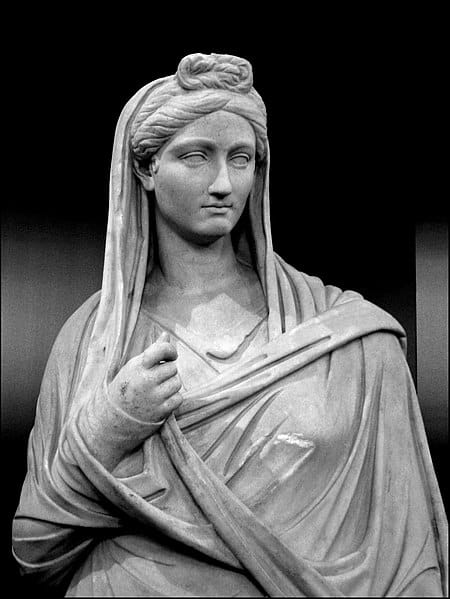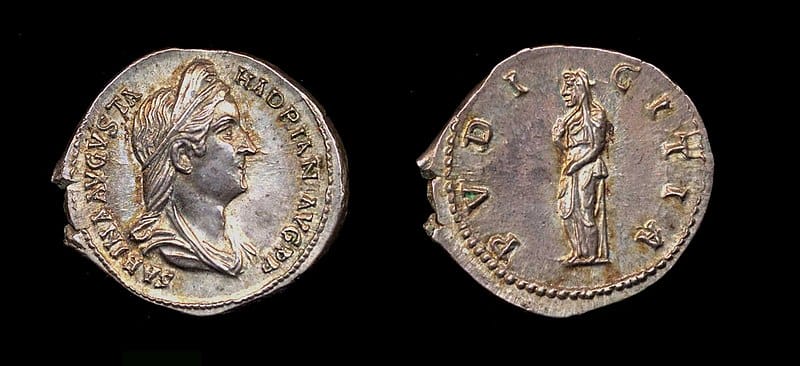Vibia Sabina was a Roman Empress known for her marriage to Emperor Hadrian and her successive role in the Roman Empire. As the wife of a distinguished ruler during a significant period of Roman history, her life and position helped shape the era’s cultural and political landscape. She procured the title of Augusta and was integrated into the sphere of imperial representation, her image on coins and sculptures, symbolizing her status and influence within the empire.

Source: Flickr: Vibia. Author: Iessi, 10 October 2006., CC BY 2.0 https://creativecommons.org/licenses/by/2.0, via Wikimedia Commons
She was often characterized by a distinct, fashion-aware style that projected an image of grace. These portraits not only served to boost her status but also played a part in communicating the power dynamics of imperial Rome. Despite the importance, details about her personal life, including her marriage to Hadrian and her influence on political affairs, are limited but remain subjects of scholarly interest. Sabina’s legacy is complex, and though she didn’t wield power in a traditional sense, her impact was felt through the cultural and societal expressions of her time.
Key Takeaways
- Vibia Sabina was a Roman Empress married to Emperor Hadrian, wielding influence through her elevated station.
- She was depicted in portraiture that highlighted cultural trends and her prominence within the empire.
- Sabina’s legacy continues to be a topic of interest, reflecting the nuances of power and representation in ancient Rome.
Early Life and Family
Noble Lineage
Vibia Sabina, an emblem of nobility, hailed from the distinguished gens Vibia, a family with a rich history of serving the Roman Republic and Empire. She was the daughter of Lucius Vibius Sabinus and Matidia the Elder, thus inheriting a lineage ripe with socio-political prestige. Matidia was the niece of Emperor Trajan, making Sabina the grand-niece of this revered ruler. Her familial network was extensive, with connections to Ulpia Marciana, Trajan’s sister, and Julia Balbilla, a close relative and companion.
Relationship with Emperor Trajan and Empress Plotina
Vibia Sabina’s relationship with Emperor Trajan and his wife, Empress Plotina, was more than familial; it was potently symbolic of her role in the imperial hierarchy. Plotina was a key figure in Sabina’s life, acting as an exemplar of imperial womanhood that Sabina was expected to emulate in her later years. Their connection was more than just personal – it was a public declaration of dynastic continuity and imperial virtue, with Sabina poised to follow in Plotina’s footsteps as an esteemed woman in the echelons of Roman leadership.
Marriage to Emperor Hadrian
Vibia Sabina’s marriage to Hadrian marked a significant union in the Roman Empire, embedding her deeply into imperial politics and establishing a partnership that would last throughout Hadrian’s reign.
Wedding and Integration into the Imperial Family
Vibia Sabina entered the imperial family through her marriage to Hadrian, whose full name was Publius Aelius Hadrianus. The exact date of their wedding is not clearly recorded, but evidence suggests it occurred before Hadrian’s accession to the throne. Empress Plotina, Trajan’s wife, is often mentioned as a key figure who may have influenced their union. The integration of Sabina into the imperial family set the stage for her future role within imperial politics.
Dynamic with Hadrian
The marriage between Sabina and Hadrian is notable for its complexity. Historical accounts hint at a partnership that may have experienced emotional distance; however, these accounts should be approached critically, as personal relationships in historical contexts are often shrouded in rumor and conjecture. Nevertheless, it is apparent that Sabina accompanied Hadrian on his travels throughout the empire, indicating a level of involvement and presence alongside the emperor.
Involvement in Imperial Affairs
As empress, Sabina had certain roles and responsibilities in state affairs. She was visible in public ceremonies and on imperial coinage, which was a standard method of expressing status and influence in the Roman world. Important administrative decisions, such as the adoption of Antoninus Pius, Hadrian’s successor, could have involved Sabina to some degree, although the direct extent of her influence in such matters of state remains the subject of historical debate.
Depiction and Portraiture
Vibia Sabina, an Empress of Rome, is depicted in various mediums of ancient art, showcasing the styles and techniques of Roman portraiture through her preserved images and coins.
Iconography and Symbolism
The image of Vibia Sabina is replete with iconographic elements that bring out her imperial status and personal attributes. She is often depicted with an elaborate hairstyle, signifying nobility, with each bun and wave symbolizing both fashion and dignity. The forehead and ears are typically exposed in these images, following the aesthetic customs of the time. Her portrait coins specifically might bear symbols demonstrating her role in Roman religion and society.
Surviving Artifacts and Coins
Coins offer a tangible glimpse into Sabina’s iconography, where her portrait is struck with a high degree of detail. Surviving coins from 128 to 138 AD present five different portrait types, illustrating changes in her depiction over time. Artifacts, including statues and busts, further exhibit her image. One notable example is a 3D model of her portrait from a 2nd-century AD sculpted funerary portrait found at the Villa Albani in Rome.

Source: Portable Antiquities Scheme from London, England, CC BY 2.0 https://creativecommons.org/licenses/by/2.0, via Wikimedia Commons
Style and Technique
Roman art employed specific styles and techniques to sculpt and carve the portraits of imperial figures. Sabina’s portraits reveal a refined technique with a focus on realistic depiction rather than idealization. The handling of the hair, crafting of the facial features, and the lifelike representation of fabrics reflect the style of the period, demonstrating a sophisticated level of skill and attention to detail by the artists.
Cultural and Political Influence
Vibia Sabina wielded cultural and political influence in the Roman Empire, particularly through her patronage and her relationships with other imperial women.
Patronage and Public Works
Empress Vibia Sabina, as a Roman Empress and Augusta, was a prominent patron of the arts and public works. Her patronage often extended to cultural affairs, contributing to the embellishment of the Empire.
- Temple Constructions: She was associated with the construction and restoration of various temples, including those dedicated to the Goddess Diana.
- Cultural Sponsorship: Sabina’s influence is noted in the support of artistic endeavors, establishing her legacy in the cultural landscape of the time.
- Public Asset Development: The Empress is credited with the commissioning of statues and the development of public spaces, signifying her role in enhancing Roman civic life.
These efforts not only demonstrate her commitment to the cultural evolution of the Empire but also highlight her ability to navigate within the political area traditionally reserved for men, asserting her influence through more socially acceptable channels like art and religion.
Death and Legacy

Vibia Sabina’s death and subsequent deification leave a legacy that has been examined and commemorated by later generations.
Circumstances Surrounding Her Death
Records from ancient sources are scarce on the specific details of Empress Vibia Sabina’s death. However, it is generally acknowledged that she passed away in 136 or 137 AD, with Suetonius and the Historia Augusta offering limited insights. While suicide is not explicitly mentioned in these historical texts as the cause of her death, the absence of clear evidence has not prevented speculation on the nature of her demise. None of the sources directly suggest that Sabina took her own life, therefore, it remains a matter of conjecture.
Deification and Memorialization
Following Vibia Sabina’s death, she was deified by her husband Emperor Hadrian, a customary honor for a deceased empress. This divine ascent affirms her importance and reverence within the Roman imperial lineage. Artifacts and statues, like those housed in the Musei Capitolini, stand testament to Sabina’s memorialization. Tokens of her worshiped status were spread across the empire, from coins bearing her image to grand sculptural tributes, ensuring her memory was preserved and worshipped by the public.
Historical Perspectives
The legacy of Vibia Sabina has been a subject of debate among historians due to the sparse and often contradictory accounts from ancient Roman sources. While the Historia Augusta and works by Suetonius provide fragmented glimpses into her life, the full extent of her influence and the degree to which she contributed to or was affected by the politics of her time remains illuminated only in parts. Her portrayal in these sources is often overshadowed by the prominence of Emperor Hadrian, yet she remains a figure of intrigue in Roman history.
People Also Ask:
What is known about the death of Vibia Sabina?
Details about Vibia Sabina’s death are scarce, but historical texts suggest she died in 136 or 137 AD. The cause of her death remains unknown, and her passing preceded Emperor Hadrian’s by about three years.
How did Hadrian and Vibia Sabina’s relationship influence the Roman Empire?
The relationship between Hadrian and Vibia Sabina, though reportedly strained, was significant. Their union solidified Hadrian’s position within the Nerva–Antonine dynasty. Despite apparent personal discontent, they maintained public decorum, which helped stabilize Hadrian’s rule and thus contributed to the empire’s continuity during his reign.
What were the significant achievements of Hadrian during his reign?
Hadrian is credited with several significant achievements including consolidating and fortifying the empire’s borders, most notably with Hadrian’s Wall in Britain. He also rebuilt the Pantheon, initiated numerous building projects in Rome and across the empire, and reorganized the military.
How did Hadrian meet Antinous, and what was the nature of their relationship?
Hadrian met Antinous, a young Greek from Bithynia, during one of his imperial tours. Antinous became a favorite companion of the emperor, and their relationship, often described as intense and personal, led to Antinous being deified by Hadrian after his mysterious death in 130 AD on the Nile.
What is the historical significance of Trajan’s marital status?
Emperor Trajan, Hadrian’s predecessor and adoptive father, was married to Pompeia Plotina. Plotina was known for her philosophical interests and, significantly, for her role in advocating Hadrian’s adoption and succession. This marriage set a precedent of female influence in the imperial succession process.
In what ways did Vibia Sabina contribute to Roman society as Empress?
As Empress, Vibia Sabina contributed through her representation of imperial female virtues and her portrayal in art and coinage, which reinforced the image of the imperial family. Her visibility and actions during public rituals and ceremonies also helped to define the role of the empress in Roman ceremonial life.
Hello, my name is Vladimir, and I am a part of the Roman-empire writing team.
I am a historian, and history is an integral part of my life.
To be honest, while I was in school, I didn’t like history so how did I end up studying it? Well, for that, I have to thank history-based strategy PC games. Thank you so much, Europa Universalis IV, and thank you, Medieval Total War.
Since games made me fall in love with history, I completed bachelor studies at Filozofski Fakultet Niš, a part of the University of Niš. My bachelor’s thesis was about Julis Caesar. Soon, I completed my master’s studies at the same university.
For years now, I have been working as a teacher in a local elementary school, but my passion for writing isn’t fulfilled, so I decided to pursue that ambition online. There were a few gigs, but most of them were not history-related.
Then I stumbled upon roman-empire.com, and now I am a part of something bigger. No, I am not a part of the ancient Roman Empire but of a creative writing team where I have the freedom to write about whatever I want. Yes, even about Star Wars. Stay tuned for that.
Anyway, I am better at writing about Rome than writing about me. But if you would like to contact me for any reason, you can do it at [email protected]. Except for negative reviews, of course. 😀
Kind regards,
Vladimir
